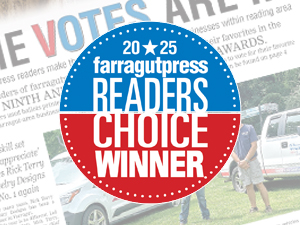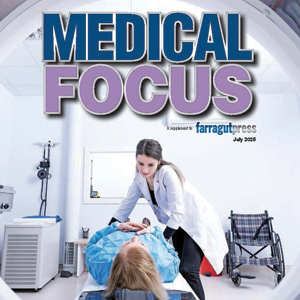Latest ‘light’ round of White vs. Hale, rest of BOMA
Farragut Board of Mayor and Aldermen’s meeting turned tense Thursday, Dec. 8, during deliberations on amendments to the Town’s lights ordinance mainly concerning ballfield lights.
In the end, the Board, on first reading, voted 4-1 in favor of the amendment, which basically establishes where the lights would be permitted. While Mayor Ron Williams, Vice Mayor Louise Povlin and Aldermen Scott Meyer and Drew Burnette voted yes, Alderman David White cast the lone no vote.
White details his objections
“First of all, this is a terrible change,” White said. “If you read the old ordinance — or the ordinance that’s in existence right now — this basically says the same thing. … The only thing that changes is the sentence they put in there that ‘any lighting associated with government-owned facilities and hosts activities for public use and attendance and ballfield lighting — temporary or permanent — shall only be permitted in areas where it is directly associated with government facilities.’
“In other words, what this ordinance is doing is giving the Board permission to do anything we want to do on government-owned property,” White added. “Well, the Planning Commission doesn’t own the property (or any other Town government body); the citizens own the property.
“Everything that protects (Farragut citizens) in the old ordinance is there — ‘no lights shall shine, glare directly onto adjacent property … to cause anyone discomfort. …’
“’All pole lights shall be directed toward the ground,’” he read. “… No light can exceed 28 feet. A pole light is a pole light, whether it’s on a ballfield, whether it’s on a parking lot, whether it’s on a highway. …”
White said the “old ordinance, which only (restricts) a pole light to be (no more than) 28 feet,” would allow private recreation businesses, such as a “golf store wanting an outdoor putting green … or anybody else, to go through the process” to get approval — or at least be approved “on a one-time basis with a special exemption.”
With 22-12, however, “they are outlawing every other kind of light” other than ballfield lighting, which would include no “tennis or pickleball court” lighting, he added.
“The latest violation of the code was done at the basketball court on McFee (Park) because this (old) code was in effect.”
White said Povlin “was terribly wrong about what she said about the old ordinance; and now we’re trying to correct those because it was done years ago.”
He said the “latest violation of the code” by the Town “was done at the basketball court at McFee (Park), which he said has light poles “well above 28 feet. They are 60-feet tall at the basketball court that was just finished.”
White’s summary
To sum up, White said, “So what they are asking you to do is give this Board permission to violate the law,” White said.
Holding up a copy of the Town’s book of ordinance, the Alderman said, “People, this right here, this is the law — as stated by the (Town) Charter, this is civil law.
“We can’t keep breaking this.”
Despite his strong disagreements with Shipley, Hale and apparently his four BOMA colleagues, White did say, “everybody up here, I think they’re all good people, they work hard and they try and do the right thing — and they’ve done a lot for the Town of Farragut.
“And I’m new,” he added.
White, however, said he “took an oath … to abide by the Codes and Ordinances of the Town of Farragut.
“That’s who I’m going to be; you guys can be whoever you want to be,” he added.
“But if you vote yes on this ordinance, all you’re doing is giving this Board permission to thumb their nose at our constituents and say, ‘Hey, we don’t have to follow the code because our attorney has already told us, ‘we don’t have to abide by the code.’”
Hale, Povlin, Shipley make their case
Ordinance 22-12, the “revised language” of which is a collaborative effort from Hale and Shipley, was developed after Town staff “received an application from the Farragut Neighborhood Preservation Partnership a few months ago to have our outdoor site lighting revisited, specifically in relation to ballfield lighting,” Shipley said during the meeting.
The bottom line, he said, was: “we’re just clarifying, in this ordinance, what has been in place for, really, decades.”
Getting feedback at workshops and appearances before Farragut Municipal Planning Commission, Shipley said the new 22-12 language seeks to clarify “differences between ballfield and tennis court lighting; deal with where ballfield lighting may be envisioned in the future, particularly on government property; clarifying that there are other zoning ordinances that have different lighting provisions like the Outlet Drive Entertainment Area (with Topgolf). … And clarifying issues we’ve had with complaints in residential settings where you’ve had lights that were clearly intended to create a nuisance to a neighbor. …”
After revising the amendments, FMPC approved the proposed amended ordinance, subject to BOMA approval, by an 8-1 vote Thursday, Nov. 17.
The amendments included a definition of ballfield lights, establish where the lights may be permitted and prohibit lighting that would be a nuisance.
Also included among the proposed changes in the “definitions” section “in our zoning ordinance” was “a definition of what a ballfield is,” Shipley said. Also proposed is a change within the “intent section” of that zoning ordinance, which states “the importance of protecting residents who may otherwise be adversely affected by lighting, while at the same time providing adequate lighting for safety and visibility concerns.”
Going back, “We’ve had ballfield lighting at Mayor Bob Leonard Park since the late 1980s,” Shipley said.
“Of course, we have some (ballfield lighting) at McFee Park.”
Povlin said her research found “the first Farragut zoning ordinance we adopted that referred to lighting” was in 1986, then she referenced a “Parks & Rec master plan” where “The first mention of a lighted rectangular field is in 1993.”
Further construction of lighted amenities continued through the years.
Going back more than 23 years, “It wasn’t until 1999, through Ordinance 99-16, that we adopted the outdoor lighting ordinance, from which, I guess, it has been amended over the years,” Povlin said, adding that ordinance “is the first time we mentioned pole height.
“The lights in the park came before this restriction, so in my mind, if we want to be in compliance with our lighting ordinance, this probably should have been part of that language in 1999,” she added.
Hale’s legal clarification
Concerning the Town’s legal ability to put aside code and allow the construction of ballfield light poles of greater than 28 feet, Hale said at the meeting, “Over the years, the issue has come up any number of times in the operation of the Town. The question has come up … ‘Do we have to abide by the zoning ordinance when we’re creating public facilities for us by the public?’ … I’ve researched this issue over the years, and the law is very clear that the majority view, in the United States of America among the states that have considered the question, ‘Is that municipal governments do not have to abide by their zoning ordinances when they are exercising the use of their property in what is known as a governmental function, as opposed to a proprietary function.’
“There’s no dispute about that this is what the general law is,” he added.
However, “This law has never been considered by the courts of the state of Tennessee,” Hale said. “But that happens a lot in what I do as the Town attorney. The courts of this state have not answered a lot of questions.”
As a result, “We generally will follow the majority view of the other states,” he said.
“I’m fine with this,” Povlin said about Hale’s answers.
“The attorney has worked through the language and feels comfortable with basically stating what we’re already doing.”


